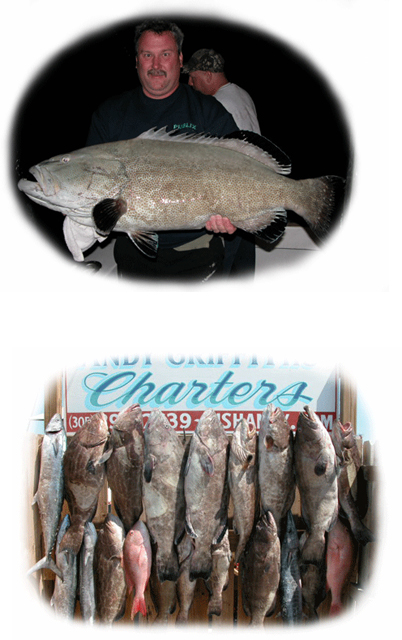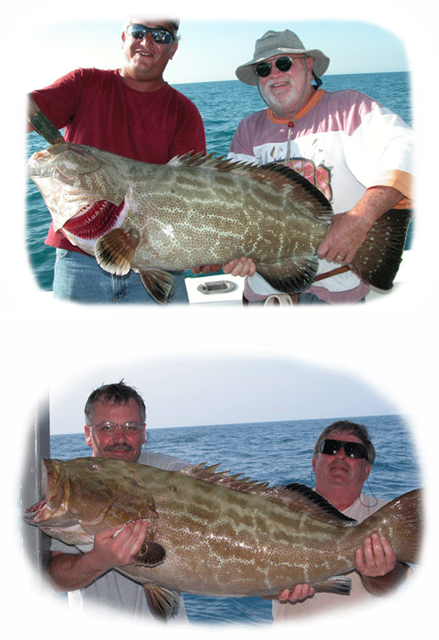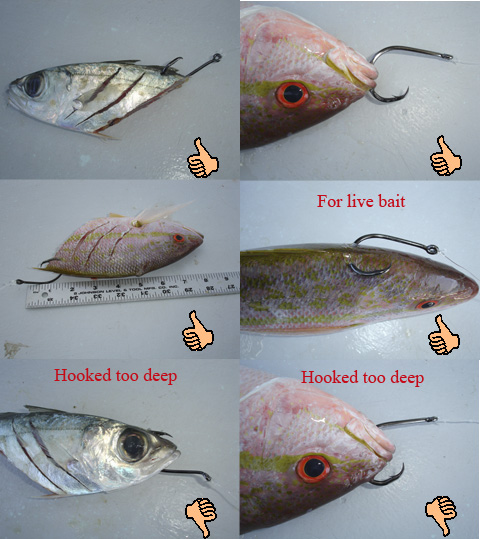|
|
|
Black Grouper
::::::::::::::::::::::::::::::::
 |
 |
A hefty bottom dweller, the black grouper can reach a weight of over 100 lbs. Many fish over 50 lbs. are cought in Key waters year round. Even smaller fish of 20-30 lbs. fight hard and are known for their short, high torque runs. On the reef, they are usually found close to their hiding hole, and often get "rocked up" after being hooked by the angler. The usual result of this is a cut leader. This is always followed by the cussing of the disappointed angler.
Black grouper prefers deeper water, especially during warmer summer months. During the winter and spring however, they can be found quite shallow.
Many anglers have good success trolling diving plugs on the edges of the shallower reef bottom. Especially, the blacks become more active and hungry, just before a cold front. They will readily come off the bottom and nail anything that looks like food.
Because black grouper can be found in such of range of depths (30-300 ft.), the methods and tackle used to catch them can be quite different. Please check out the suggested tackle page on more info. I will discuss several general fishing situations that we encounter on our trips to the Dry Tortugas.
Black grouper spawn in March and April over reef bottom usually in 30-120 ft. of water. This is when the majority of them are cought by anglers in the Winter/Spring months. Another type of black grouper fishing is done in deeper water - 120-250 ft. There, the black grouper can be cought year round. They usually hold around some sort of structure like a ledge, hard bottom, or a wreck. They are not as concentrated in the deep as they are on the reef, but run larger in size. Over the years I have cought dozens of fish over 50 lbs., majority of them on the reef.
|
|
There are few things that an angler needs to keep in mind when targeting black grouper (remember that the fish will break all the rules from time to time). I find that the tackle most fisherman are using for general bottom fishing, is just too light for black grouper on the reef. The blacks are masters at picking up the bait, and making a mad dash to the nearest hiding hole in the reef, often before the angler gets even a chance to react. The result of this is usually a broken leader. Unlike most other grouper, the black grouper that is lost, is not likely to hit the bait again for quite some time. Most anglers will only get one or two chances at a trophy fish during the trip, so a broken leader is not an option.
80 lb. gear is not too heavy when targeting big blacks on the reef. If using lighter gear, I reccomend using a 6'-8' of #6 or #7 wire leader. Black grouper will hit the wire almost as well as mono, and will greately increase the chances of getting one in the boat. Using a heavy mono leader and much lighter main line does not work as well in keeping the blacks out of the structure. Heavier main line and tight drag are required to muscle the bigger fish away from the structure. Even heavy monofilament cuts very easily against the coral when put under tension of the hooked fish.
Reaction time needs to be quick by the angler. When you feel the unmistakeable "tick", reel like heck to quickly pick up any slack and stretch in the line. Usually, when executed properly, the hook will set itself.
Larger circle hooks work well for black grouper. These hooks are also less likely to snag bottom. I like to put slight off-set in my circle hooks using pliers. Make sure that the hooks are large and heavy. When shopping for hooks for black grouper, be careful! There are many models of expensive hooks that work well for most fish, but will straighten out or break under the heavy load of a big black.
One very important thing that seperates general bottom fishing from black grouper fishing is the size and the type of bait. It is a rare occasion when a bigger black will take a smaller bait like squid, herring, etc. on the reef. By far, the best bait for black grouper is live speedo mackarel. We hardly ever see these West of Key West and usually settle for yellowtail snapper, grunt, blue runner or similar sized reef fish for bait. Goggle eyes and tinker mackarel also work well as baits for black grouper. Over the years I have noticed that the head section of any large bait seems to work much better than the tail chunks. The blacks seem to prefer baits that are staring back at them.
The way the bait is put on the hook is very critical. Many anglers hook their bait too deep. A fish that is missed will usually not bite again. Any bait with, especially ones with tough skin, should be hooked very lightly. Try to have most of the gap of the hook exposed. The hook needs to pull out of the bait easy when the fish is hooked. Here are some examples of ways to hook baits: |
 |
 |
|
 |
 |
It is also helpful to score, crush or step on the bait to release more scent into the water. Most bottom fish will respond well to this.
The majority of black grouper fishing on the reef is done with a carolina rig and a 4'-8' leader. A good fishing technique for these freight trains of the sea is to suspend a bait about a leader length off of the bottom, rod in a holder. Always have the drag engaged. Under no circumstances leave it in free spool or on a clicker while the rod is in a holder! Aproximately every 15-20 minutes, pick up the rod and very slowly drop the bait and sinker right to the bottom. Keep the sinker absolutely motionless on the bottom. Wait for the unmistakeable "tick" when the grouper sucks the bait into its mouth. Do not hesitate at all, reel immediately. 90% of the time, the black grouper will pick up the dead bait while it is sitting motionless on the bottom. If there is no bite right on the bottom after about 5 minutes, suspend the bait again and repeat the process.
On certain occasions when the current is very slow, or there is none at all, a knocker rig, or a jig in 1-3 oz. size is deadly for blacks. On the reef, keep the knocker/jig right on the bottom, no movement. Out in the deep, a jig in the 2-6 oz. size, can be used for jigging when tipped with dead bait like ballyhoo or squid. Sometimes, it is possible to get away with no weight whatsoever. Just drift the bait slowly to the bottom and wait for a bite. I like to use a dead or wounded bait for this during slack tide. The amount of weight to use depends on the strength of the current. This tecnique works awsome for blacks, but requires more skill to execute properly. Be prepared to snag bottom quite often.
Patience pays when after the bigger blacks. Extensive chumming at one spot for long periods of time is very effective. First light or just before sunset is the best time. Usually, when there is larger yellowtail snapper around, so is the black grouper.
Fishing for black grouper in water over 120 feet is only slightly different. First, even though the fish usually run slightly bigger, one can get away with using lighter gear. There is usually less structure for the grouper to get into. 30-50 lb. test line is OK unless you are fishing over a wreck or other heavy structure. Higher speed reels can be advantageous in deeper water. They help to pick up the slack and stretch of monofilament faster to drive the hook home.
A 1-3 lbs. yelloweye or vermillion snapper is not too big of a bait for the grouper out in the deep. The deep water grouper are generally not as picky about the type and size of the bait as are the grouper on the reef.
Jigging for black grouper while drifting over deep ledges and other structure is very productive. It can only be done under certain conditions and requires slightly different tackle and technique. I will discuss how to do this in the future. I will also be adding some more info on trolling for grouper.
© Copyright 2005 Dry Tortugas Fishing Adventures |
|
|